Westerkerk
| Westerkerk | |
|---|---|
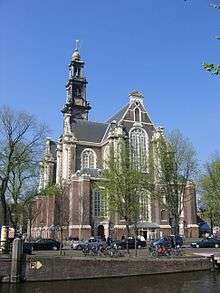 Westerkerk in 2005 | |
| Basic information | |
| Location | Prinsengracht 281,[1] Amsterdam, Netherlands |
| Geographic coordinates | 52°22′28″N 4°53′1″E / 52.37444°N 4.88361°ECoordinates: 52°22′28″N 4°53′1″E / 52.37444°N 4.88361°E |
| Affiliation | Protestant Church in the Netherlands |
| Rite | Protestant Reformed |
| Ecclesiastical or organizational status | Parish church |
| Website | www.westerkerk.nl |
| Architectural description | |
| Architect(s) | Hendrick de Keyser |
| Architectural style | Dutch Renaissance |
| Completed | 1631 |
Westerkerk (Dutch pronunciation: [ʋɛstərkɛrk]; English: Western Church) is a Reformed church within Dutch Protestant church in central Amsterdam in the Netherlands. It is next to Amsterdam's Jordaan district, on the bank of the Prinsengracht canal.
History
The 'Westerkerk' was built between 1620 and 1631 in Renaissance style, built according to designs by architect Hendrick de Keyser (1565-1621). He is buried in the church he designed earlier: the 'Zuiderkerk'. The building of the Westerkerk was finished and completed by his son Pieter de Keyser (1595-1676) and inaugurated on June 8, 1631. The church has a length of 58 meters and a width of 29 meters. The high nave is flanked by the two lower aisles. The three-aisled basilica has a rectangular plan with two transepts of equal dimensions. As a result, the plan for this church was given the form of two Greek crosses connected with each other.[2] (a patriarchal cross).
Several older churches in Amsterdam, such as Oude Kerk and Nieuwe Kerk, were originally built before the Reformation and were converted to Protestantism during the Reformation in 1578. The Westerkerk was one of the first purposely built Protestant churches. The Noorderkerk and Zuiderkerk preceded the Westerkerk. Today the Westerkerk remains the largest church in the Netherlands that was built for Protestants, and is still in use by the PKN (Protestantse Kerk in Nederland)
Main Duyschot organ
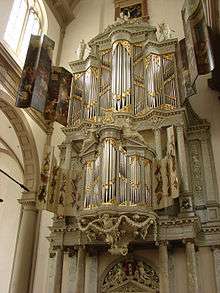
There was no organ when the Westerkerk was consecrated on Whit Sunday the 8th of June in 1631. According to Calvinism, playing instrumental music inside the church was still considered 'profane' in those days. It took many years of consultation until an organ was finally allowed. At first there was still talk of moving the small organ (koororgel) used in the Nieuwe- or the 'Oudekerk' but the pipes of this 'Oudekerk' choir organ were finally moved to the 'Zuiderkerk'. In 1681 the Westerkerk decided on commissioning organ builder Roelof Barentszn Duyschot for the construction of a new organ. Before it was finished he died and in 1686 the new organ was finished by his son Johannes Duyschot. Later in 1727 it was enlarged with an extra third keyboard by Christiaan Vater who learned his profession at Arp Schnitger.
Many alterations were done on the organ in the course of time. In the 19th century in 1895 even a rebuild of the inside of the organ took place by Daniel Gerard Steenkuyl. Lucky enough many of the old pipes and the wind chests were re used. In 1939, the keyboard was equipped with electric tracker action and even a swell work was added. It was not what this organ was intended to be in sound and action. The organ was almost doubled in size, but was also too big for its case.
So between 1989 and 1992 the organ was reconstructed by Flentrop organ builders in Zaandam to its former mechanical action again more or less like Christiaan Vater made it in 1727. Today the 'bovenwerk' (Oberwerk, located in the top of the organ case) is still almost complete with stops by Vater. An exception is the 'baarpyp', which is made by Steenkuyl in 1896 and the 'Dulciaan' which is made by Flentrop in 1992. The front pipes were made in 1842 by Hermanus Knipscheer. In the situation after 1992, less than half of the pipes are historic and re-used in the 'hoofdwerk' (Great organ) and the 'Rugwerk' (Chaire organ). The keyboards and stop triggers beside it of this just mechanical baroque organ are located in the main case behind this 'rugwerk'. For this kind of baroque organs, it is characteristic that many of the stops, mainly the principals, are doubled in the trebles. This was set up to create more power in leading the congregation in their psalm singing. For complex organ works one or even two stop assistants are necessary for triggering these stops.[3]
In the summer season from April till the end of October there is a weekly free lunchtime concert on Friday at 1pm. In August there is a free concert almost every day for a week 'Geen dag zonder Bach' ('Not a day without Bach') and the 'Grachten' (Canal) festival. A noncommittal money collection is held after the concert at the exit. The money is used for the costs of the maintenance of the concerts and the organs. Music by Johann Sebastian Bach (1685-1750) is performed almost weekly in the divine Sunday services. Bach was born in 1685, that is a year before the organ was finished but as far as we know, he never visited Amsterdam. His music sounds like it was made for this baroque instrument. See the site of Westerkerk for the Lunchtime concert schedule.
Organist/choirmaster (for the Cappella) in the Westerkerk is Jos van der Kooy.[4]
Stoplist of the Duyschot Organ
|
|
|
| ||||||||||||||||||||||||||||||||||||||||||||||||||||||
Couplers and shutters:
- Shutters for all manuals and pedals.
- Couplers: I/II, II/I, III/II, I/P, II/P, III/P
- Td = Treble is doubled
The paintings of the organ



The inside of the organ shutters of the 'hoofdwerk' was painted by Gerard de Lairesse. On the left panel we see the dancing and playing King David in front of the Ark of the Covenant. On the right panel we see the Queen of Sheba presenting gifts to King Solomon. Both stories in the book of Kings in the old testament of the Bible. Gerard de Lairesse was born in Liège in French Belgium in 1640 and he moved to Amsterdam in 1664. In the second half of the 17th Century, he was one of the most popular painters in the Netherlands. At this moment, the shutters of the Duyschot organ can be seen on a retrospective of the work of Gerard de Lairesse at the National Museum Twente in Enschede. The outside paintings of these panels or shutters were lost in the 19th century when the church wanted to sell them. The grisailles on the 'rugwerk' panels were also painted by Gerard de Lairesse; The four evangelists with their items are showen. The inside of the 'rugwerk' shutters have paintings of old musical instruments. The complete organ was cleaned and re-painted in 1992 in its original state of colour in 1686; most of it in marble imitation.
Ds. A.H. Visser organ
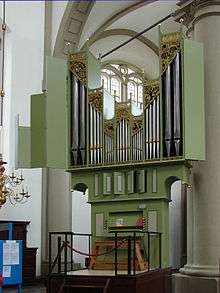
The small organ on the east side of the church was built in 1963 by D.A. Flentrop from Zaandam. It was revoiced and slightly altered in 2001. In that year it was named after the minister Ds. H.A Visser who was the man begging for money to buy the organ in 1963. He succeeded. The organ has 12 stops over 2 manuals and pedal. Since 1963 the organ case was in not painted but plain oak wood. After the renovation it was painted in a light green color.
Stoplist
|
|
| |||||||||||||||||||||||||
- Couplers: II/I, I/P, II/P
The tower with the spire

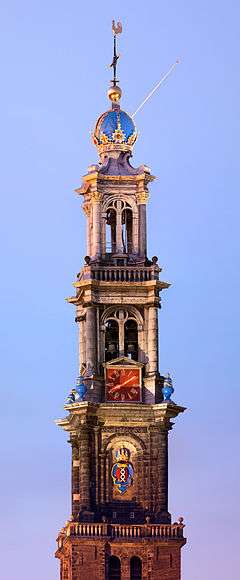
The tower, called the Westertoren ("Western tower"), is the highest church tower in Amsterdam, at 87 meters (±286 feet). It is not known who the designer of the spire was. Hendrick de Keyser designed an octagonal spire for the tower which was never build. It is suggested Jacob van Campen was the designer. The crown topping the spire is the Imperial Crown of Austria of Maximilian I.[5]
Bells in the 'Westertoren'
Just above the clock-faces is the carillon. The largest 14 of the 51 bells in this carillon were cast by François Hemony in 1658. The modern bells were cast in 1959 by Eijsbouts replacing the by pollution damaged bells. In 1991 three bells more were added by the same foundery. The not in use smaller Hemony bells can be seen in the tower together with the original baton keyboard from the 17th century. The carillon was enlarged to 4 octaves and is tuned in Meantone temperament.[6] It is the only carillon in the city chiming the entire twenty-four hours over Amsterdam. (On request of the 'Jordaan' people) The drum to do this, was made by Jurriaen Spraeckel from Zutphen in 1659 and it still chimes every quarter of the hour to announce the hour and half hour strike. On the quarter of the hour a short tune is performed. The two strike bells were made by Assuerus (Ahasverus) Koster in 1636. The hour strike bell (F0) is the largest in Amsterdam (7509 kg) and is hung in the room for the carillon. The text on this Bourdon bell is: 'VERBUM DOMINI MANET IN ETERNUM - ASSUERUS KOSTER ME FECIT AMSTELDAMI 1636' The smaller bell (A1) for half hour is hung in top of the spire just under the crown. Weekly on Tuesday at noon the city carilloneur gives his recital on the carillon for an hour. He is also responsible for the tunes on the drum and changes these twice a year. At this moment (2015) Boudewijn Zwart is the City Carilloneur.
In a lower chamber behind the sounding boards in the tower wall there are three swinging bells also made by François Hemony in 1658. The largest swinging bell was replaced after 27 years by Claude Fremy (his pupil, nephew and successor), because it was cracked. The bells (a major triad) are rung to announce the divine service on Sunday and also when the service is on, during praying the 'Our Father'. This bell by Fremy is also connected with the pedals in the baton keyboard of the carillon. The latest renovation works on the carillon were in 2006 when the tower was also renovated. In that year the crown on top was also painted in its original blue color.
Rembrandt

Rembrandt van Rijn was buried somewhere under a tombstone in the Westerkerk[2] on October 8, 1669. The exact location of the grave is unknown; the number of his grave was lost. It was in a numbered 'kerkgraf' (grave owned by the church). There is a memorial marker on the north wall, made in 1909 after a model on the 'Nachtwacht'. After twenty years, his remains were taken away and destroyed. That was customary with the remains of poor people at that time. Rembrandt was buried as a poor man[2] Every year on his birthday anniversary the 15th of July he is remembered in the Westerkerk with a lunchtime concert with music from the time of Rembrandt's life and flowers are hung on his memorial marker.
Rembrandt's lover Hendrickje Stoffels was also buried here, as was Rembrandt's son Titus van Rijn.[2] Other painters buried in the Westerkerk are Nicolaes Berchem, Gillis d'Hondecoeter, Melchior d'Hondecoeter and Govert Flinck.
Dutch Royal Family
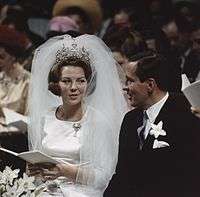
On March 10, 1966, Princess Beatrix married Prince Claus von Amsberg in the Westerkerk. The 'Nieuwe Kerk' on Dam square where Royals normally have the weddings, was in renovation at that time.
Anne Frank
The Westerkerk is located close to the Anne Frank House where diarist Anne Frank, her family and others were hid in the 'Achterhuis' from Nazi persecution for two years during World War II. The Westertoren is mentioned frequently in her diary - its clock-face on the tower could be seen from the attic of the Achterhuis and Anne Frank described the chiming of the carillon as a source of comfort. A memorial statue of Anne Frank is located outside the church at Westermarkt.
Burials
- Nicolaes Pietersz. Berchem (1620-1683), painter
- Jan Bicker (1591-1653), shipbuilder and merchant
- Joan Blaeu (1596-1673), printer, publisher and cartographer
- Steven Blankaart (1650-1704), physician and entomologist
- Samuel Blommaert (1583-1651), merchant, director of the Dutch West India Company
- Anthonie van Borssom (1631-1677), painter and draughtsman
- Pieter de Carpentier (1586-1659), Governor-General of the Dutch East India Company
- Frederick Coyett (1615/1620-1687), last Dutch governor of Dutch Formosa (present-day Taiwan)
- Govert Flinck (1615-1660), painter
- Johann Rudolph Glauber (1604-1670), German pharmacist and chemist
- Pieter van Gunst (1658/9-1732), painter
- Gillis d'Hondecoeter (ca. 1575-1638), painter
- Melchior d'Hondecoeter (1636-1695), painter
- Rembrandt van Rijn (1606/1607-1669), painter
- Titus van Rijn Son of Rembrandt (1641-1668)
- Hendrickje Stoffels Mistress of Rembrandt (1626-1663)
- Albertus Seba (1665-1736), pharmacist and collactor
- Jacques Specx (1585-1652), merchant who established the Dutch trade with Japan and Korea
- Isaak Tirion (1705-1765), book trader and publisher
- Hendrick van Uylenburgh (ca. 1587-1661), art trader
Notable people
- Cristina Pumplun, missionary vicar
Bibliography
- ISBN 9789062785438 I Roelfs Jan en Balk Jaap Th. - De oude Wester 350 jaar. uitg. Tiebosch 1981 (in Dutch)
- ISBN 978-8716758002 Balkenende Maria - De orgels van de Westerkerk in Amsterdam (incl cd) (in Dutch)
- ISBN 90 331 03729 Seijbel Maarten - Orgels rond het IJsselmeer blz 113-115 (in Dutch)
- Prof. F.C. Stam - Het hoofdorgel van de Westerkerk te Amsterdam. (small booklet in Dutch)
Canon of Amsterdam
- The Westerkerk is window number 14 in the Canon of Amsterdam.
References
- ↑ (Dutch) Contactgegevens, Westerkerk. Retrieved on 19 June 2014.
- 1 2 3 4 Martin Dunford (2010). The Rough Guide to The Netherlands. Penguin. pp. 72–73. ISBN 978-1-84836-882-8.
- ↑ See in this piece 'Fète Dieu' by Hendrik Andriessen how the stops work. Organ played by Iddo van der Giessen and his father and Evan Bogerd on the stops
- ↑ Jos van der Kooy performing Bach on the Duyschot organ
- ↑ "The Westerkerk". Rough Guides. Retrieved 12 March 2011.
- ↑ Boudewijn Zwart performs: Sonata in d (2 parts) by Baldassare Galuppi - Choral 'Ich ruff zu Dir' by Johann Sebastian Bach - Entry of the Gladiators by Julius Fučík and Wien bleibt Wien by Johann Schrammel.
External links
| Wikimedia Commons has media related to West Church. |
| Dutch Rijksmonument 4298 |
- Westerkerk, official website
- Listen here to the latest Friday lunchtime organ recitals